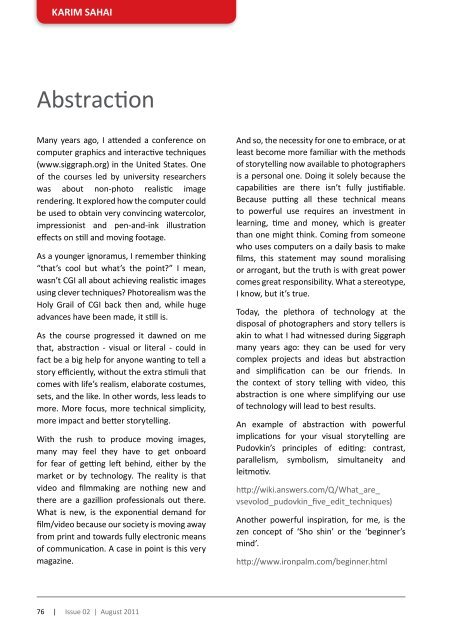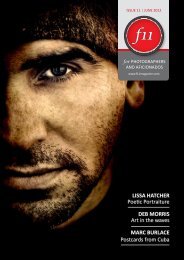SUE BRYCE Portrait Couture CAMUS WYATT Unobtrusive LEON - f11
SUE BRYCE Portrait Couture CAMUS WYATT Unobtrusive LEON - f11
SUE BRYCE Portrait Couture CAMUS WYATT Unobtrusive LEON - f11
You also want an ePaper? Increase the reach of your titles
YUMPU automatically turns print PDFs into web optimized ePapers that Google loves.
KARIM SAhAI<br />
Abstraction<br />
Many years ago, I attended a conference on<br />
computer graphics and interactive techniques<br />
(www.siggraph.org) in the United States. One<br />
of the courses led by university researchers<br />
was about non-photo realistic image<br />
rendering. It explored how the computer could<br />
be used to obtain very convincing watercolor,<br />
impressionist and pen-and-ink illustration<br />
effects on still and moving footage.<br />
As a younger ignoramus, I remember thinking<br />
“that’s cool but what’s the point?” I mean,<br />
wasn’t CGI all about achieving realistic images<br />
using clever techniques? Photorealism was the<br />
Holy Grail of CGI back then and, while huge<br />
advances have been made, it still is.<br />
As the course progressed it dawned on me<br />
that, abstraction - visual or literal - could in<br />
fact be a big help for anyone wanting to tell a<br />
story efficiently, without the extra stimuli that<br />
comes with life’s realism, elaborate costumes,<br />
sets, and the like. In other words, less leads to<br />
more. More focus, more technical simplicity,<br />
more impact and better storytelling.<br />
With the rush to produce moving images,<br />
many may feel they have to get onboard<br />
for fear of getting left behind, either by the<br />
market or by technology. The reality is that<br />
video and filmmaking are nothing new and<br />
there are a gazillion professionals out there.<br />
What is new, is the exponential demand for<br />
film/video because our society is moving away<br />
from print and towards fully electronic means<br />
of communication. A case in point is this very<br />
magazine.<br />
And so, the necessity for one to embrace, or at<br />
least become more familiar with the methods<br />
of storytelling now available to photographers<br />
is a personal one. Doing it solely because the<br />
capabilities are there isn’t fully justifiable.<br />
Because putting all these technical means<br />
to powerful use requires an investment in<br />
learning, time and money, which is greater<br />
than one might think. Coming from someone<br />
who uses computers on a daily basis to make<br />
films, this statement may sound moralising<br />
or arrogant, but the truth is with great power<br />
comes great responsibility. What a stereotype,<br />
I know, but it’s true.<br />
Today, the plethora of technology at the<br />
disposal of photographers and story tellers is<br />
akin to what I had witnessed during Siggraph<br />
many years ago: they can be used for very<br />
complex projects and ideas but abstraction<br />
and simplification can be our friends. In<br />
the context of story telling with video, this<br />
abstraction is one where simplifying our use<br />
of technology will lead to best results.<br />
An example of abstraction with powerful<br />
implications for your visual storytelling are<br />
Pudovkin’s principles of editing: contrast,<br />
parallelism, symbolism, simultaneity and<br />
leitmotiv.<br />
http://wiki.answers.com/Q/What_are_<br />
vsevolod_pudovkin_five_edit_techniques)<br />
Another powerful inspiration, for me, is the<br />
zen concept of ‘Sho shin’ or the ‘beginner’s<br />
mind’.<br />
http://www.ironpalm.com/beginner.html<br />
If you are thinking and visualising stories that<br />
are all about motion and sound, the abstraction<br />
which comes without the ‘beginner’s mind’<br />
will greatly ease the relatively daunting task of<br />
assembling the visual, auditory and contextual<br />
blocks of your story. A proponent of simplicity<br />
and abstraction in storytelling and presentation<br />
is the excellent Japan-based Garr Reynolds.<br />
Watch his keynote presentation about the<br />
reasons technologies that offer the greatest<br />
breakthroughs in efficiency often never realise<br />
their full potential.<br />
http://www.citrix.com/tv/#videos/403)<br />
Until next time.<br />
Karim Sahai<br />
karim@<strong>f11</strong>magazine.com<br />
www.karimsahai.com<br />
Karim Sahai is a photographer and feature films<br />
computer visual effects artist based in Wellington.<br />
http://www.guardian.co.uk/film/2001/<br />
aug/31/artsfeatures1<br />
http://www.scribd.com/<br />
doc/57782489/Technique-of-Film-<br />
Editing-2nd-Ed-0240521854<br />
http://www.archive.org/details/<br />
filmtechniqueand010615mbp<br />
76 | Issue 02 | August 2011 <strong>f11</strong> for PhoToGrAPhErS And AfICIonAdoS | 77



